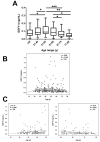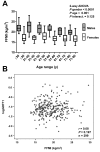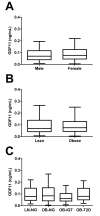Circulating GDF11 levels are decreased with age but are unchanged with obesity and type 2 diabetes
- PMID: 30897065
- PMCID: PMC6461177
- DOI: 10.18632/aging.101865
Circulating GDF11 levels are decreased with age but are unchanged with obesity and type 2 diabetes
Abstract
Growth differentiation factor 11 (GDF11) is a member of the transforming growth factor β (TGFβ) superfamily which declines with age and exerts anti-aging regenerative effects in skeletal muscle in mice. However, recent data in humans and mice are conflicting casting doubts about its true functional actions. The aim of the present study was to compare the circulating concentrations of GDF11 in individuals of different ages as well as body weight and glycemic status. Serum concentrations of GDF11 were measured by ELISA in 319 subjects. There was a significant increase in GDF11 concentrations in people in the 41-50 y group and a decline in the elder groups (61-70 and 71-80 y groups, P=0.008 for the comparison between all age groups). However, no significant correlation between fat-free mass index (FFMI), a formula used to estimate the amount of muscle mass in relation to height, and logGDF11 was observed (r=0.08, P=0.197). Moreover, no significant differences in circulating concentrations of GDF11 regarding obesity or glycemic status were found. Serum GDF11 concentrations in humans decrease in older ages being unaltered in obesity and T2D. Further studies should determine the exact pathophysiological role of GDF11 in aging.
Keywords: GDF11; aging; fat-free mass; obesity; type 2 diabetes.
Conflict of interest statement
Figures



Similar articles
-
Circulating Concentrations of GDF11 are Positively Associated with TSH Levels in Humans.J Clin Med. 2019 Jun 19;8(6):878. doi: 10.3390/jcm8060878. J Clin Med. 2019. PMID: 31248139 Free PMC article.
-
Circulating Growth Differentiation Factor 11/8 Levels Decline With Age.Circ Res. 2016 Jan 8;118(1):29-37. doi: 10.1161/CIRCRESAHA.115.307521. Epub 2015 Oct 21. Circ Res. 2016. PMID: 26489925 Free PMC article.
-
Relationship of muscle function to circulating myostatin, follistatin and GDF11 in older women and men.BMC Geriatr. 2018 Aug 30;18(1):200. doi: 10.1186/s12877-018-0888-y. BMC Geriatr. 2018. PMID: 30165829 Free PMC article.
-
The role of GDF11 in aging and skeletal muscle, cardiac and bone homeostasis.Crit Rev Biochem Mol Biol. 2019 Apr;54(2):174-183. doi: 10.1080/10409238.2019.1610722. Crit Rev Biochem Mol Biol. 2019. PMID: 31144559 Review.
-
The Immateriality of Circulating GDF11.Circ Res. 2016 May 13;118(10):1472-4. doi: 10.1161/CIRCRESAHA.116.308478. Circ Res. 2016. PMID: 27174947 Review. No abstract available.
Cited by
-
Evaluation of potential aging biomarkers in healthy individuals: telomerase, AGEs, GDF11/15, sirtuin 1, NAD+, NLRP3, DNA/RNA damage, and klotho.Biogerontology. 2023 Dec;24(6):937-955. doi: 10.1007/s10522-023-10054-x. Epub 2023 Jul 31. Biogerontology. 2023. PMID: 37523061 Free PMC article.
-
Gdf11 gene transfer prevents high fat diet-induced obesity and improves metabolic homeostasis in obese and STZ-induced diabetic mice.J Transl Med. 2019 Dec 17;17(1):422. doi: 10.1186/s12967-019-02166-1. J Transl Med. 2019. PMID: 31847906 Free PMC article.
-
Metabolic Syndrome-Related Kidney Injury: A Review and Update.Front Endocrinol (Lausanne). 2022 Jun 23;13:904001. doi: 10.3389/fendo.2022.904001. eCollection 2022. Front Endocrinol (Lausanne). 2022. PMID: 35813613 Free PMC article. Review.
-
Circulating Concentrations of GDF11 are Positively Associated with TSH Levels in Humans.J Clin Med. 2019 Jun 19;8(6):878. doi: 10.3390/jcm8060878. J Clin Med. 2019. PMID: 31248139 Free PMC article.
-
A simple cell proliferation assay and the inflammatory protein content show significant differences in human plasmas from young and old subjects.Front Bioeng Biotechnol. 2024 Sep 9;12:1408499. doi: 10.3389/fbioe.2024.1408499. eCollection 2024. Front Bioeng Biotechnol. 2024. PMID: 39351061 Free PMC article.
References
-
- Afshin A, Forouzanfar MH, Reitsma MB, Sur P, Estep K, Lee A, Marczak L, Mokdad AH, Moradi-Lakeh M, Naghavi M, Salama JS, Vos T, Abate KH, et al., and GBD 2015 Obesity Collaborators. The GBD 2015 Obesity Collaborators. Health effects of overweight and obesity in 195 countries over 25 years. N Engl J Med. 2017; 377:13–27. 10.1056/NEJMoa1614362 - DOI - PMC - PubMed
-
- Gómez-Ambrosi J, Silva C, Galofré JC, Escalada J, Santos S, Millán D, Vila N, Ibañez P, Gil MJ, Valentí V, Rotellar F, Ramírez B, Salvador J, Frühbeck G. Body mass index classification misses subjects with increased cardiometabolic risk factors related to elevated adiposity. Int J Obes. 2012; 36:286–94. 10.1038/ijo.2011.100 - DOI - PubMed
Publication types
MeSH terms
Substances
LinkOut - more resources
Full Text Sources
Medical

